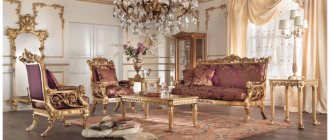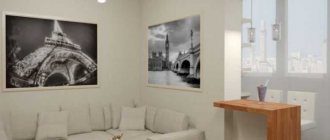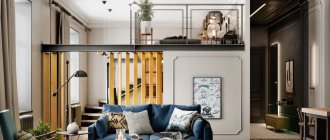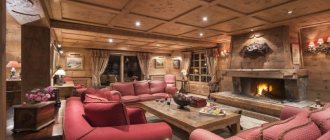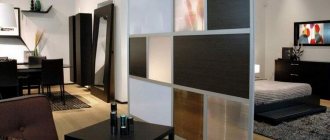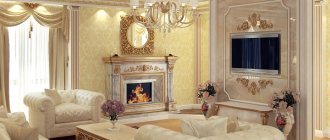Choosing a classic style for the living room interior is a decision that cannot be regretted, because discreet and cozy classics will not become outdated and will not lose their charm over time. But how to create the perfect interior and not make mistakes? What colors should I use? How to properly zone space? Everything you need to know about a living room in a classic style is in our article.
Features of the classic style
There are interior design styles that are rapidly gaining popularity or have already gone out of fashion, and there is a design that will never become outdated or lose its relevance. The classic living room is a unique and universal concept that involves creating a luxurious, elegant and cozy interior that demonstrates the respectability of the owner.
Moreover, unlike pompous baroque with flashy gilding or art deco with complex curved geometric elements, the classical style is quite restrained and carefully simple, without becoming boring or losing its attractiveness over time.
Creating a living room in a classic style will require ideal taste and subtle calculations, because, unlike many modern design options, the classic does not forgive negligence and mistakes in execution. It is not for nothing that the word “classic” itself is of Latin origin and is translated as “delightful” or “ideal.”
Complicating the task is the need to place, combine in color, materials and texture many elements necessary to create a classic living room. You can discard one or more, but without using most of them it is impossible to create a reference design:
- Fireplace with a portal and live or artificial fire;
- Furniture made of natural wood or veneer;
- Molded parts - ceiling rosettes, cornices, baseboards, columns;
- Accessories - paintings, candlesticks, figurines, vases and mirrors;
- Lighting details as a decorative element - chandeliers, sconces, floor lamps;
- Natural materials with rich texture - fabrics, wood, stone.
Symmetry and organic arrangement of furniture, strict lines and discreet patterns, exquisite details and perfect composition - these are the basic rules for organizing a classic space.
Peculiarities
If the room that needs to be decorated to create a classic living room interior is large, then feel free to continue decorating.
If this does not characterize your room in any way, then you should look for a more modest option.
Perhaps not the full embodiment of the classical style, but the use of individual elements characteristic only of it.
The room should have high ceilings and be well lit at a high level.
The design of a classic living room involves the use of high-quality pieces of furniture, as well as appropriate materials.
Keep in mind that such elements will cost you a decent amount.
It is worth noting that the interior of the living room in a classic style is elegant, proportional, which harmonizes perfectly with the overall decor.
There is no pathos in this style, it is real, maybe this is the secret to its ageless beauty.
Colors: white living room, beige, gray
The constant constancy of the classic style is also ensured by the win-win combinations of shades in its execution. There cannot be any flashy, dissonant or unnatural combinations of colors in such a living room by default.
The choice of palette for a classic interior depends on the size of the room and the level of illumination in it and is based on the soft contrast of light and dark pastel shades.
Important! If the room is not very large, then you should choose a light background with relatively dark furniture and accents, and a large, open space will allow you to use thick dark shades on the floors and walls, diluted with light furniture and textiles.
The most popular color combinations to bring this style to life:
- Beige-chocolate palette with different shades of cream, sand and khaki;
- Beige-green palette with chocolate, mustard and pistachio shades;
- A blue and white palette with various shades of ivory and blue;
- Sand and burgundy palette with chocolate or pink shades;
- White and gray palette with caramel and cream shades.
You can use more colors, but they should all be soft, natural pastel tones. Professional designers can successfully complement such an interior with bright accessories, but just a few incorrectly selected details can completely destroy the restrained harmony of the classics.
Accessories and decor: furniture, curtains, details
A living room in a classic style is usually replete with details. These include both functional items and decorative trinkets - figurines, vases, collectible dishes. The number of such elements depends on the area of the room and the pretentiousness of the design.
The decor of the living room consists of little things that are unnoticeable at first glance:
- The design of a window or several openings must be uniform . Curtains in an interior in this style are one of the important compositional elements. They are chosen in the color of the wall decoration or sofa upholstery. Windows in the living room in classicism are often decorated not only with curtains, but also with lambrequins, numerous tassels, cords, and draperies. They should be present on all openings, and similar decorations can be used in the upholstery of the sofa.
- Single details in lamps form the rhythm of the interior, its symmetry and character . Identical, for example, forged elements or textile lampshades, frills in decoration, gilded patterns will contain table lamps for the living room, floor lamps, and sconces. If there are several functional areas in the hall, several central chandeliers are used - for the guest and dining rooms separately. These lamps should also be similar.
- Dining groups will also be decorated : oval tables, ornate legs in the shape of lion paws, carvings or gilding will complement the decor of the room.
- Paintings are most often used as decoration on the walls . These can be either traditional classical works or panels with ornaments in luxurious baguettes - without plots or painting. Such panels are arranged symmetrically in pairs or in compositions of 3-5 pieces - depending on the area of the room.
- The walls are decorated with panels of photographs - antique, family, city, or, conversely, with a rustic theme.
- Among the traditional classical elements are columns or their imitation in fireplaces, doorways, and arches.
Various details must be balanced, otherwise the living room will be overloaded. Therefore, it is important to take into account and balance the basic tone of the design, the solemnity of the setting, and the number of decorative elements.
Living room in a classic style: modern interior design
Just a few decades ago, a classic interior could only be created from expensive natural materials - precious wood, natural stone, silk, velvet, and so on. Today, a variety of finishing materials allows you to successfully imitate wooden, plaster and stone surfaces and avoid enormous costs .
However, fine imitation and crude counterfeiting are not the same thing, so the quality of artificial materials should be met with no less demands than with natural ones.
When choosing a coating, you should follow several immutable rules in order to maintain the chosen style and not disturb the overall composition.
Walls
The walls of a classic living room can be either a neutral and unobtrusive background or a decorative element. This style allows you to create compositions on the walls from stucco moldings, wooden or fabric panels, use wallpaper with prints and plain ones at the same time, and create an unusual texture using decorative plasters. However, you should use such artistic techniques carefully so as not to oversaturate the interior with details - the use of complex wall decoration implies restraint in furniture and textiles .
Ceiling
Unlike the Baroque style, the classic ceiling does not require special attention - neither painting nor gilded elements. However, if the ceiling height is sufficient, you can use plain stucco molding - ceiling roses, baseboards and moldings . If the living room is in an apartment with a standard ceiling height, it is better to avoid the use of heavy elements, leaving a flat, uniform surface. In some cases, it is possible to use a glossy texture to visually increase its height.
Classic style living room furniture
The first image that appears when you hear the phrase “classic interior” is wooden, heavy cabinet furniture in dark or natural shades, armchairs and sofas with colored fabric upholstery and carved armrests, elegant banquettes, poufs and tables.
All elements must be combined with each other, both in shape and shades, and the arrangement of furniture in the living room must obey the principles of zoning and symmetry. The use of abstract or irregularly shaped furniture such as triangular tables or asymmetrical shelves is strictly unacceptable.
In addition to wooden furniture, it is allowed to use forging, glass tabletops without metal chrome parts, stone decorative elements and fireplace portals.
Curtains for the living room in a classic style
Textiles are one of the main components that create the atmosphere of a classic interior. Professional designers use complex draperies made of heavy natural fabrics, lambrequins, tiebacks and tassels in combination with weightless tulle to decorate windows, creating a real work of art from curtains.
With the help of curtains, you can decorate absolutely any space - like a window in an apartment with low ceilings, a sunny bay window of a complex shape, or panoramic windows of a modern penthouse. Window textiles are another way to change the geometry of space .
You can visually raise the ceiling with the help of flowing vertical folds on the curtains or soften the sharp corners of the bay window with lambrequin waves - in the hands of a master, an ordinary curtain becomes a professional tool and the main decoration of the living room.
The main rule when decorating a window in a classic interior remains the same - maintaining symmetry and using pastel shades. In this case, you can use a wide variety of fabrics - plain and patterned, heavy and light, natural and artificial. Caution should only be exercised in the texture of the material, because the classic design involves matte surfaces without shiny lurex or organza sparkling in the sun.
Current color schemes for living room design in a classic style
For classic living rooms, as a rule, a noble color scheme is chosen, consisting of cream, milky, pearl gray and beige shades, and gold and silver are used as a complement. Well, if you want bright colors, the neutral palette can be “diluted” with wine, blue, turquoise chocolate or marshmallow pink accents.
Cream tones
All photos In the photo: Luxurious living room with second light in the interior of a country house
Milk, cream, vanilla, cappuccino - designer Anzhelika Prudnikova considers delicate cream colors to be the best choice for a classic interior. In combination with white color, it creates a festive atmosphere in the room, which is very important for the living room.
Wine shades
All photos In the photo: Classic living room of a private house in the communal enterprise “La PROMENADE”
Noble wine shades harmonize perfectly with the beige-golden palette and make the classic interior of the living room in the photo brighter and more expressive. Thanks to their elegant shape, the sofas do not overload the space, but only unobtrusively place the necessary accents.
Turquoise and blue accents
All photos In the photo: A bright living room with turquoise and blue accents in the interior of a country house in Grozny.
Decorative piping in a beautiful sky blue color on the backs of armchairs and sofas adds invigorating notes of sea freshness to the interior of the living room. And the Mediterranean mood is supported by blue pillows and a stained glass ceiling in turquoise tones.
White and pink colors
All photos In the photo: Exquisite white and pink living room with a fireplace and mirrors in the Grand Park residential complex.
Marshmallow white and pink tones create a romantic mood in the living room with a fireplace and mirror panels. Thanks to the combination of several shades of pink and materials with different textures, the interior turned out to be complex and multifaceted, and the gilded stucco molding made it truly luxurious.
Delicate spring greenery and luxury of gold
All photos In the photo: Sofa area in the classic living room of a two-room apartment
The classic design of the living room with an abundance of gilded elements only benefited from the presence of textile decor in the color of delicate spring greenery. Beautifully draped curtains and pillows made the furnishings of the new apartment more cozy and up-to-date.
Living room in classic style with fireplace
The fireplace is rightfully considered the heart of a classic living room. And today the range and quality of electric fireplaces is so extensive that installing a fireplace in an ordinary apartment does not pose any problem.
The most important thing in the interior layout is to correctly determine the place for the future hearth, because it will become the center of the furniture group and should be clearly visible from anywhere in the living room. When placing a fireplace in a dark room with windows facing north, you can decorate the walls framing it with mirrors, expanding the space and filling it with light.
The design of the fireplace portal also plays an important role in the design. Most often, carved wood, brick, stone or their imitations are used to create a frame. The portal should be in harmony with the rest of the interior and echo the furniture, stucco molding and other decorative elements of the room.
also be used to zone the space - for example, mount it in a column separating the dining area from the living room area with sofas and armchairs.
Don’t forget about fireplace accessories - even if an electric version of the hearth is installed, forged fireplace tools and grates will add comfort and individuality, bringing the illusion of a real fire to perfection.
Living room in modern classic style
The classic style of the living room interior places increased demands on the furniture and lighting of the room. An individual order based on a specially completed design project is the best way to decorate a room. If this is not possible, you should take into account a simple rule: quality, good quality, elegant beauty, clarity of lines and shapes are always taken into account when choosing furniture. An important detail: the furniture should be quite impressive in size, the sofa and armchairs should not have sharp corners.
Solid natural wood of noble species is always a win-win choice for furniture. Only this option will suit the interior with a fireplace area.
The upholstery of such furniture should be either leather or thick expensive fabric to match the overall color scheme of the living room drapery and somewhat darker than the wall decoration. Satin, jacquard, velor, tapestry - what should you choose if the living room and its decoration are given to the classic style.
The legs of the sets are selected with an exquisite shape and are also made of solid wood. Tabletops and coffee tables can be made of durable glass, if this does not conflict with other interior details. The fireplace area creates a special semantic center of a living room in a classic style. Modern design and renovation, which includes decorating the room with a fireplace, lead to the choice of a suitable architectural option. Fireplaces are stationary and mobile, closed and semi-closed, corner and island. Closed ones are equipped with a chimney in the wall and planned at the beginning of construction work. Open fireplaces are often placed in the center of the room. It evenly provides warmth to the room and advantageously emphasizes its uniqueness and style. It is worth considering that a wood-burning fireplace requires an area of at least 20 square meters. If for technical reasons it is not possible to install it, an electric fireplace may be an alternative proposal.
The cladding and decoration of fireplaces is made of brick, wood, stone, ceramic tiles and marble blocks. Portal design - from granite, marble, stone, ceramics, brick, limestone, metal. Classic style is impossible without elegant and sufficient lighting for a large space. A room, by definition, should have a lot of natural light. A massive chandelier is a must. It can be multi-level in pendants and decorated with candelabra. There are many variations, but it all depends on the size of the room. Lighting fixtures containing crystal, natural gilding, and bronze will fit appropriately into a design that suggests a classic style. Modern neoclassicism also gives preference to the attributes of the classical lighting solution chosen by the time.
The design of a classic living room involves the use of large quantities of candlesticks, sconces and spotlights. They allow you to create a cozy, intimate atmosphere and achieve additional zoning of the area with light.
Kitchen-living room in a classic style: design features
The concept of a combined kitchen and living room area appeared in our country not so long ago, but quickly gained popularity, and rightly so - because this approach allows you to expand the space and avoid unnecessary partitions and corridors.
The main principle in designing a classic kitchen-living room is to create the most light and light space, all areas of which are in harmony in style, color and shapes used. The most popular colors in decoration are shades of beige, caramel, warm gray and olive.
Classic kitchen sets are often a real decoration of the interior with carved facades, balustrades, multi-level shelves and beautifully shaped domed hoods. Manufacturers equip such kitchens with stylized household appliances, decorated with patterns and aged fittings that imitate bronze, metal or brass.
In a combined space, it is necessary to take care of the harmonious combination of the kitchen set and living room furniture, avoiding sharp contrasts and dissonance.
A kitchen island, bar counter, sofa backrest or low display case will help to separate the two zones. You can also use different floor coverings or even floor levels for separation - to do this, you need to raise the kitchen area, creating a podium. Also, thanks to the vast space in the design of the kitchen-living room, you can use columns or an arch that will help zone and decorate the room.
Color spectrum
The classic living room is decorated in a consistent and natural color scheme, but complex shades are used. In the foreground are light milky, cream and pastel colors or all shades of wood. As accents - deep and noble wine, emerald, sapphire, terracotta, grape.
White living room in classic style
If you have a relatively small space that you want to enlarge, or you like more restrained interiors, use white as a base. But keep in mind that classic is not a sterile snow-white laboratory or cold steel high-tech. Use milky or cream shades, combine white with wood, use complex textured materials.
Brown living room in a classic style
Brown is perhaps the most classic color in the interior, and certainly one of the most diverse. You have at your disposal any shades of natural wood: from the lightest to almost black or reddish. Use wooden furniture, cover the walls with brown panels, lay parquet flooring, use tapestries, bedspreads and other accessories.
Red living room in classic style
One of the most daring and extravagant solutions is the red living room. The classic style is an excellent opportunity to make it noble and not too aggressive: the main thing is to choose the right shade. You don't need fire scarlet, but ruby, garnet, burgundy, cherry, marsala and any other complex variations are an excellent choice for luxurious classicism.
Blue living room in classic style
If you have a large and bright room with south-facing windows, you can refresh it and make it airier with shades of blue. For the classics, you have two options: pastel cornflower blue tones or deep and rich azure, ultramarine, sapphire and dark shades of the night sky. Deep turquoise and sea green look interesting - they also naturally fit into classic interiors.
Green living room in a classic style
If you want to always feel fresh and be able to relax or unwind, choose calm green shades. But instead of herbaceous and light green, pay attention to dark emerald, malachite, marsh shades, pistachio, olive and mint. Such a wide range of possibilities allows you to design the interior in both light and dark colors - to suit your taste.





